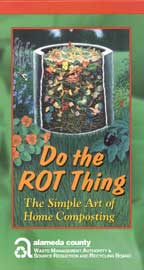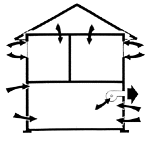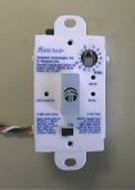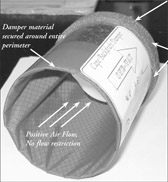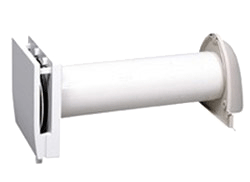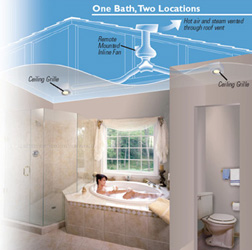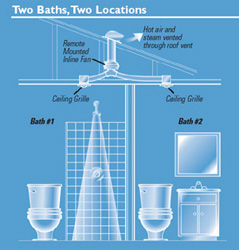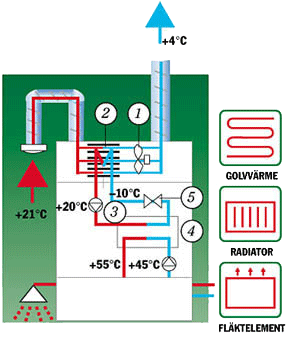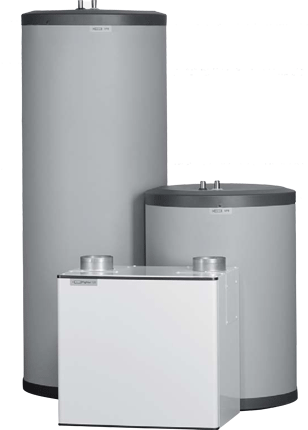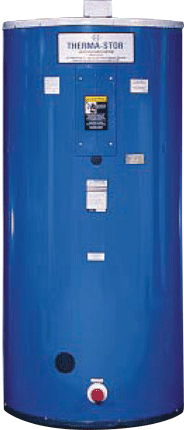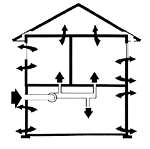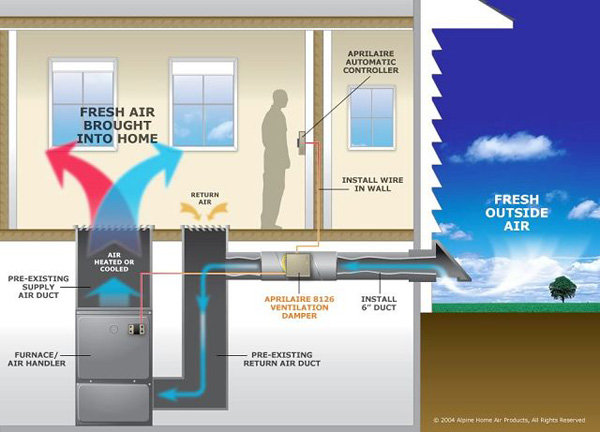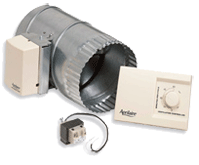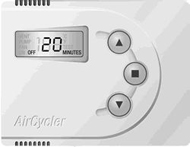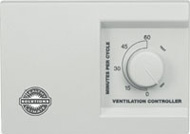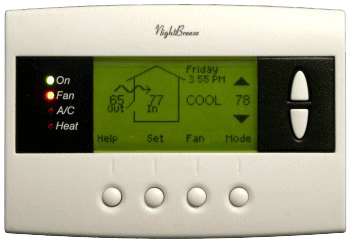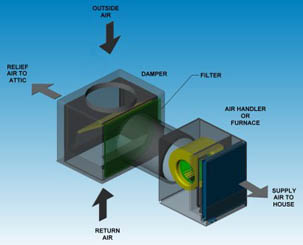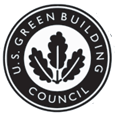July 2007 News and Tips
The Remodel Guidance "Construction Chronicles" is a bi-monthy newsletter which features and celebrates successful projects, gives tips to navigating the construction process, and keeps readers updated on the latest news and events. Rest assured that your email address will not be sold or traded, nor used for spam purposes. If you wish to discontinue receipt of this newsletter, simply send an email to unsubscribe@remodelguidance.com. If you did not receive this email correctly, or would like to see past issues, simply follow this link.
Contents
- Project Report: The Summer of the Second Unit
- Tips: Finding the Right Pro for Your Project
- Green Building: "Save Water, Look To the Landscaping", "Wasted Water Equals Wasted Energy", "Healthy Indoor Air: Green Building Materials Aren't Enough", "Size Matters"
- About Remodel Guidance
- Meet the Designer
- News & Upcoming Events: Marin County 2nd Unit Amnesty Ends in December, Remodel Guidance at San Rafael 2nd Unit Workshop, MMWD 2nd Unit Price Cuts, Remodel Guidance joins NorCal Solar, Upcoming Classes in Marin, San Francisco and Sonoma Counties
- In the Works: Projects appearing in future issues
- Contact Us
1. Project Report: The Summer of the Second Unit
As we explained in RGCC, September 2006 (see "Tips: Working Wisely with the Seasons of Construction") construction is a seasonal business. Right now we're in the "heat of battle," with a number of projects underway, but none completed. Accordingly, this month's edition of the Construction Chronicles will highlight three second unit projects, two recently approved and one under construction. We think this is an exciting trend! -ed.
In RGCC, March 2007 (see "Tips: Add a Second Unit"), we saw that residential second units became easier to approve in California in 2003, at least in theory. A State law ("AB 1866") was passed requiring local planning departments to provide set of criteria (know as a "Second Unit Ordinance") which, when met, would provide for approval of residential second units without public hearings (know as "ministerial approval.") Indeed, most planning departments in California acknowledged AB 1866 with a Second Unit Ordinance, with varying degrees of enthusiasm.
Some local governments were progressive, and made a good faith effort to provide a feasible Second Unit Ordinance while accounting for their community's concerns. Others did not, and created Second Unit Ordinances which were difficult, if not impossible, for people to utilize. The State Assembly responded in 2004 with AB 2702 which, in effect, "restricted the restrictions" that local governments could place on Second Unit projects. This law was met with stiff resistance, and was vetoed by the then new governor. Indeed, many (if not most) Second Unit Ordinances violate one or more of the principals of AB 2702. There's now a running joke that "California now has more LAWS about second units than it does second units." An August 28, 2005, article in the San Francisco Chronicle, "Not in our backyard: A new state law was supposed to make it easier to build in-law units, but city restrictions mean they might as well be outlawed" detailed difficulties a number of people had faced, and generally painted a grim picture of the approval process.
Regardless, where there are reasonable Second Unit Ordinances, we do not find the permitting process to be the main challenge (after all, we teach classes about these matters.) The challenge is in the design - making these small homes livable and pleasant for tenants and homeowners alike. Below are some examples of recent projects.
As we discussed in March, second units are a very green housing option - promoting infill, reducing sprawl, increasing housing near existing public transit, and building community by fostering income and generational inclusion. In addition, their small size makes them green too, requiring fewer resources to construct and less energy to inhabit and operate. Accordingly, we have highlighted the additional green features particular to each of our projects.
- An "In Law Unit" for an Actual "In-Law"
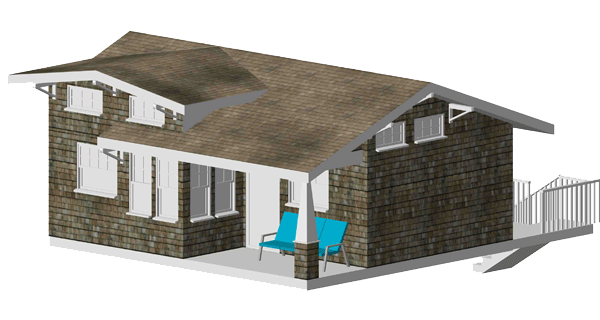
This Craftsman inspired second unit was recently approved by San Anselmo's Planning Department. It was designed for, and with, a grandmother who will live in it behind the home of her son, daughter-in-law and two granddaughters. Squeezing every square inch of usable space out of its 423 square feet was a top priority, as was its appearance and "visitor friendliness."
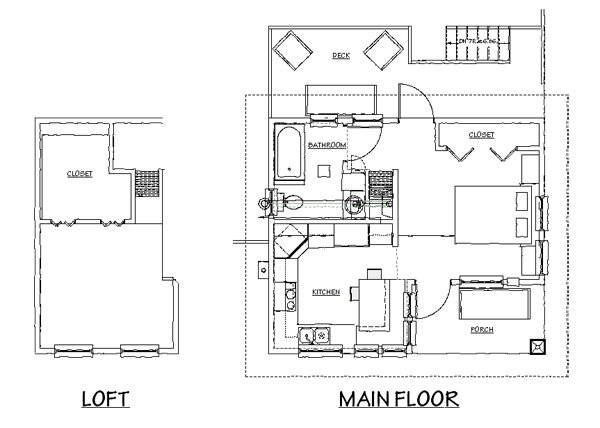
Our answer was a large kitchen, with a "breakfast nook" for visitors to socialize and enjoy grandma's cooking. The sleeping area features a "Murphy bed" which folds up out of the way when not in use, flanked by bookshelves and a "secretary" writing desk. The covered porch in front, and the deck in back, expand the living space in fair weather. There's a sleeping loft for guests above the bathroom and kitchen. This home was designed with "Universal Design" principles in mind with the expectation that it be user friendly for the resident now and easy to modify for increased accessibility as she "ages in place."
Green Features
The home will be heated with a high-efficiency sealed-combustion gas fireplace and equipped with a tankless water heater mounted outside. These devices provide for energy efficiency and healthy indoor air. The crawlspace beneath the home will be a sealed and insulated space, providing for better insulation and indoor air quality and extra storage. A Panasonic "WhisperGreen" exhaust fan will provide for continuous air exchange (see "Healthy Indoor Air: Green Building Materials Aren't Enough," below.) The building will be constructed with OVE Framing techniques and good insulation, including under and around the slab, and the interior fixtures and finishes will be chosen for healthy indoor air (see "Indoor Air Quality: Care About Your Health? Move to China!!!???", RGCC March 2007.) Overall, good insulation, efficient appliances and green building practices and products will made this home healthy and environmentally friendly, as well as attractive and comfortable.
- A Passive Solar Garden Cottage
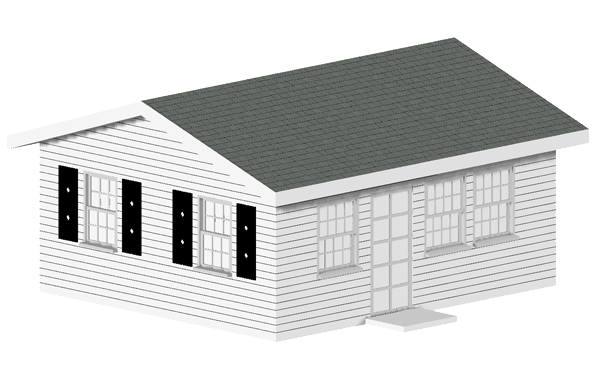
This more modest example was also recently approved by San Anselmo's Planning Department. The 382 square foot garden cottage is intended as a rental unit, to help the young family who owns the property meet their financial obligations. Later on, it may serve as a home office/guest cottage. It was designed to match the Colonial Revival architecture of the primary residence, on a slab to minimize its profile in the back yard.
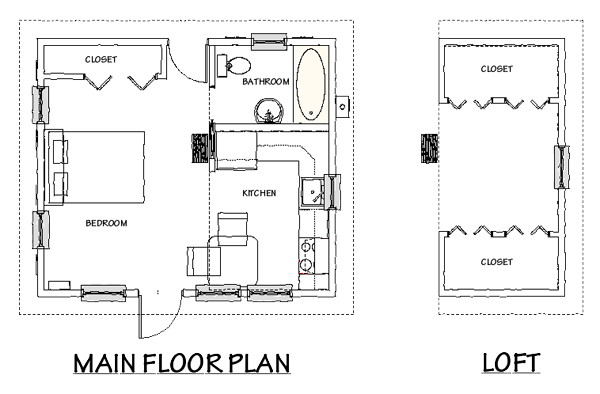
Like the previous example, this home features a "Murphy bed" on the main floor and a loft above the kichen and bathroom. There are two entry doors, one nearest the walkway to the street and the other a French door opening on the garden. Ample windows, an open floorplan, the loft, and plenty of storage should make this small home "bigger" than its square footage suggests.
Green Features
As this home will be built on a concrete slab and oriented toward the South, it was designed for passive solar heating, with appropriate roof overhangs, passive solar windows and window placement, well-insulated roof, floor and walls (perhaps constructed from SIPs), and a backup radiant heating system in the floor. The domestic hot water and water for the radiant floors will both be heated with a single efficient "tank type" water heater, which is compatible with future solar thermal panels on the South facing roof. This second unit, like the one previous, will have a continuous cycle bathroom fan for IAQ air exchange (see "Healthy Indoor Air: Green Building Materials Aren't Enough," below.) Like the example above, the interior fixtures and finish will be chosen for good IAQ (see "Indoor Air Quality: Care About Your Health? Move to China!!!???", RGCC March 2007.)
- A 1920s Style Cottage with Cutting Edge Features
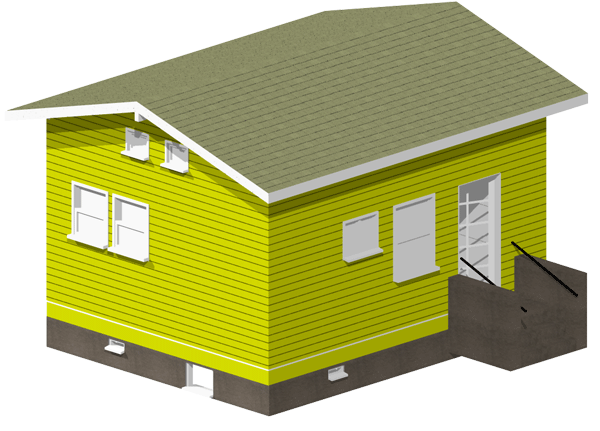
This 1920s style 2nd unit was the first approved in Fairfax under the Town's new Second Unit Ordinance.
It was built from scratch to match the existing main residence, a restored 1922 California bungalow. The intent was to make the cottage look as if it were built at the same time as main house. Accordingly, the windows and doors were salvaged from 1920s houses slated for demolition, as were many of the plumbing fixtures and kitchen cabinets. Located in a flood zone, the floor of the cottage had to be elevated 2 feet above the ground. To save lumber, materials and labor, the foundation was poured with tall stem walls, and the concrete was colored with lampblack and finished with the pea-gravel aggregate exposed, a common technique in the 1920s.
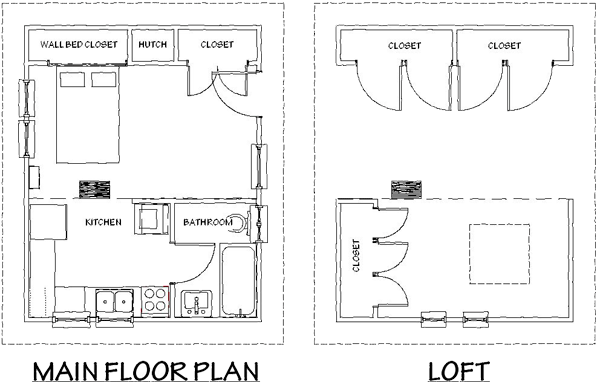
The interior features an antique Murphy bed, salvaged from an apartment in San Francisco. There is also a sleeping loft above the kitchen and bathroom with storage cabinets along one side. The awning windows in the loft are antique Craftsman-style art glass, chosen for ambience and privacy for the main house. Above the closet and the Murphy bed cabinet are additional storage cabinets which reach to the vaulted ceiling. The storage cabinets and the loft are accessed by a rolling library ladder, which can be switched between two tracks. The cottage was built with 10 foot tall walls, to increase the usable area in the loft.
This house is still under construction, but the exterior is nearly complete, and here's a photo:

Green Features
This second unit has salvaged 1920s Craftsman-style single-pane windows, but they have been restored and throughly weatherstripped. (Contrary to common perception, this is not green building sacrilege, as we will discuss in a future issue.) The building will be throughly sealed and insulated and is plumbed with structured plumbing, a water and energy-saving technique. A continuous-operation bathroom fan will provide for air exchange (see "Healthy Indoor Air: Green Building Materials Aren't Enough," below.) The domestic hot water will be provided by a Thermosiphon solar water heater, which we will also discuss and display in a future edition.
2. Tips: Finding the Right Pro for Your Project
Most construction projects are a challenge, especially when they involve your own home. Last issue (in the tip "Relax, Breathe, and Enjoy the Ride!!!") we discussed the importance of feeling comfortable with the project plans, process and personnel before and during construction. A crucial part of a successful and enjoyable experience is finding the right professionals: if your project is too big or too small for them, it does not bode well for you. Like Goldilocks, you need your project to be "just right!"
If your project is too large for the contractor(s), designer and/or architect you're considering, the problem is obvious - it is beyond their capability. If it is too small, you will find it difficult to retain the attention of your team when other projects that let them "hit their stride" arise.
So, in addition to getting referrals from folks you know and people in your area who've completed nice projects, and checking the references of the referrals you get, you need to compare the scope and scale of your project to the "reference jobs" to be sure they're comparable. If the referral projects are much more modest (or much more elaborate) in scale, scope and/or budget to the project you're undertaking, these are not good references for you. Perhaps the person you're considering has more comparable examples in their portfolio and that's where you'll need to look. Lastly, consider the time frame of each project - every business starts somewhere, and businesses change over time in scale and scope. The most recent projects are the best indication of where the professional you're considering is now.
At Remodel Guidance we know what we do well, and we stick to it. Our core business is designing attractive, comfortable and cost-effective homes, additions and remodels. We don't design commercial buildings or hospitals or churches. We don't design mini-malls or production tract homes either. We don't tell you that your ideas are wrong, or insist we're right - we work WITH our clients to find the best solution for their needs, desires and budget, and try to ensure that each project is a wise investment.
We do 3D CAD drafting and rendering because it's fast, effective and clear. We don't spend a lot of your time and money pontificating about the theoretical aspects of your project, we get down to business and get the job done (we'd rather "dance about the architecture and talk about music!")
We understand construction and engineering from both a theoretical AND a hands-on perspective, so we can design to get you the most "bang for the buck." We're dedicated to green building, not just because it's good for the planet and healthy for our clients, but because much of it is just a better, smarter way to build. (That said, we recognize that there are many "shades" of green and that there's no one "right" or "best" approach - we help our clients make choices that suit them best.) Again, our aim is to design beautiful, functional and practical homes, additions and remodels, not make "architectural statements." If you're seeking a pretentious architectural firm with attitude, you're better off elsewhere.
At the other end of the scale, we are not a drafting service. Our drafting is in service to our designs. If you're doing a project that requires very simple drawings, or no creative input, we'll happily steer you elsewhere.
We ARE experts in navigating the "maze" of planning and building restrictions, and we're happy to consult for any project on those matters (and offer our experienced opinion), regardless of whether or not it leads to additional work for us.
If you think we might be able to help you plan or design your next project, and/or offer advice on one you're currently involved in, please feel free to contact us at 415-258-4501 or email info@remodelguidance.com.
3. Green Building
In this section, we provide tips on Resource Conservation, Energy Efficiency and Indoor Air Quality (IAQ), as well as Liveable Community ideas, when relevant. (See "Green Building: An Introduction" in RGCC January 2007 for an orientation.)
- Resource Conservation: Save Water, Look To the Landscaping
|
At the height of summer in a record dry year in California, we felt it appropriate to discuss water conservation. We'll be talking about indoor water savings next time, but we thought we'd start with the place where most water is used and wasted - outdoors:
According to the State of California Department of Water Resources, in 2003, single family residences used 28.25% of their water indoors and 71.75% outdoors. Residential water demand in California accounts for 54% of total urban water demand and is forecasted to reach 58% by the year 2020 as a result of population growth, especially in the hotter, inland regions of the state. See "Greenery sucking up more of state's water," San Francisco Chronicle, July 13, 2006, for more info.
The California Energy Commission states that urban water use constitutes about 20 percent of the water used in California, or 8.8 million acre-feet per year, of which 54% is residential, so homes in California use about 4.752 million acre-feet (AF) of water per year, of which 71.75%, or 3.4 million acre-feet, is used outdoors, enough to the entire state with nearly half of an inch of water.
Coupled with problems caused by the shear volume of water consumption are issues of groundwater, watershed and waterbody pollution, which are directly related to excessive watering and the use of toxic chemicals in landscapes and gardens.
What Can We Do?
StopWaste.org, program developed by the Alameda County Waste Management Authority and the Alameda County Source Reduction and Recycling Board, offers the following water conservation advice:
- Use locally adapted plants
- Learn how much water your plants need
- Group plants by water needs
- Water according to need
- Monitor your soil
- Use compost to create drought-resistant soils
- Use mulch to prevent water loss
- Water to encourage deep root growth
- Make every drop of irrigation water count
- Control weeds
- Minimize the lawn
We'll look at more suggestions and some ideas in more detail below but first, for inspiration, take a peek to the right. (Despite the fact that this is the #1 site for land subsidence in the United States, it doesn't seem to be much of a tourist attraction! - ed.)
|
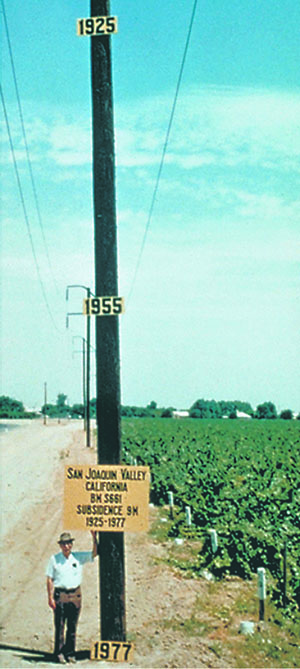 |
| Approximate location of maximum subsidence in the United States identified by research efforts of Dr. Joseph F. Poland (pictured). Signs on pole show approximate altitude of land surface in 1925, 1955, and 1977. The site is in the San Joaquin Valley southwest of Mendota, California.
Source: USGS Fact Sheet-165-00: Land Subsidence in the United States, December 2000
|
The Marin Municipal Water District offers these tips to save water outdoors:
- Maintain your irrigation system. Check for water leaks, pipe breaks or clogged sprinklers and replace/repair as needed.
- Reduce watering. Plants are typically over-watered 20-50 percent, lawns expecially. Reduce watering times 2-5- mintues for every 10 minutes on your timer. Consider subscribing to MMWD’s online weekly watering schedule.
- Install a “smart” controller that will adjust the irrigation system when evaporation is lowest.
- Do not run automatic irrigation systems during the day. Irrigate in the early morning or evening when evaporation is lowest.
- Participate in MMWD’s new Bay-Friendly Landscaping Rebate Program and replace older irrigation equipment with more water-efficient products.
The East Bay Municipal Utility District offers the following advice in "WaterSmart Tips: Saving Water in the Yard"
- Water less frequently but more deeply
- Adjust your irrigation controller according to the seasons
- Reduce urban runoff caused by long irrigation cycles
- Exchange your irrigation controller for a Water-Smart Irrigation Controller
- Routinely check your irrigation system for leaks
- Choose drip irrigation
- Select plants that are adapted to Mediterranean climates
- Group plants in Hydr-O zones
- Apply mulch to your garden
Taking a cue from the City of Santa Rosa's compelling titled publication "How to Save Money and Conserve Water in your Santa Rosa Garden," we get these suggestions:
- Water WHEN you need to
- Water WHERE you need to
- Use mulch and berms to hold water
- Aerate and mow high
- Let your plants and soil tell you when they need water
- Maintain and upgrade your irrigation system
- PLAN your garden's water use
- PLANT your garden for low water use
The City of Santa Rosa has a compelling reason for this compelling publication, as they state: "From June through September, approximately ˝ of the water used citywide is applied to landscapes. With forethought and planning, it is estimated that landscapes can be well maintained using 20-50% less water."
Are you seeing a pattern? Motivated to act? Aside from learning more by following the links below, we've synthesized a list of seven easy "no-brainer's:"
Easy, "No-Brainer" Steps to a Greener Garden
- Practice tough love with your plants
Plants actually suffer with overwatering. Adequate, deep watering leads to healthy plants with deep root systems and reduces mildew and other problems caused by excessive moisture. To do this effectively, plants must be grouped by water needs. You need also to consider the effects of "Evapotranspiration (ETo)." Basically, the water needed by landscape follows a bell-shaped curve through the dry season. A typical "dumb" irrigation controller supplies the same quantity of water throughout the season, as the diagram below illustrates:
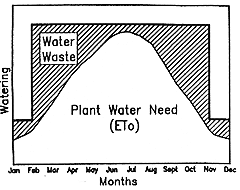
To address this issue, you'll need to:
- Manually adjust your timer/irrigating on a weekly basis, or
- Manually adjust your irrigation controller's "Season Adjust" setting on a weekly basis, or
- Install a "smart" irrigation controller which adjusts itself.
Where does one get this "ETo" information? The Marin Municipal Water District has a telephone recording which is updated weekly, as well as a website, which also allows you to subscribe to a weekly email. Other water districts offer similar features. Indeed, MMWD offers rebates for the purchase of "smart" irrigation controllers, and do others.
- Water when it's cool, but not in the evening
Watering in the heat of the day not only wastes water due to evaporation, but it can shock and kill plants to be suddenly chilled with water. Watering in the late afternoon or evening can leave plants wet overnight, and contribute to mildew and mold, so it's best to water early in the morning, while the plants are cool and before they face the heat of the day. For this reason alone, automatic irrigation controllers are very attractive.
- Get your yard off the drugs!!!
The use of chemical fertilizers and pesticides is unhealthy for the environment. In fact, all Bay Area creeks and the Bay itself have been impaired due to pesticide and chemical runoff. Beyond that, many of these chemicals are toxic to humans, pets and wildlife. Excessive fertilizer use, and the use of pesticides destroys the ability of your landscape to maintain itself without these chemicals, actually "addicting" your garden to them. A healthy, balanced landscape should need little to no intervention, beyond careful watering, occasional pruning and weeding and seasonal fertilization with organic matter. If you're struggling with pests, weeds and watering, you should look at the underlying issues and build the natural systems up, not reach for the "Round Up," pesticides and "Miracle Grow."
- Limit the turf
Lawns certainly have their appealing characteristics and their place, but they can be a demanding form of landscaping. Standard sod is a very high water user (requires about 1.2 inches, or 3/4's of a gallon per square foot, per week), requires constant maintenance (often with air polluting machinery) and demands either intense cultivation or chemical intervention to maintain it's unnatural "monoculture" environment. Reducing sod will not only save you money, water and time, but you can create a much more interesting, beautiful and enjoyable space with the energy and money you used to expend for grass. In short, use turf where turf is useful. For decoration, pick something hardier and more decorative. Where you are using turf, look for "no mow" and "low water" varieties. A common refrain is that "it's great for the kids to play on," but when was the last time you saw a playground with sod on it? Furthermore, do you really want your kids running barefoot and rolling in a landscape sodden with chemical fertilizers, pesticides and herbicides?
- Mulch it up
Applying a layer of organic matter around plants enriches the soil, reduces water needs, keeps plants' roots cooler and controls weeds. It's also a great use for all those Fall leaves.
- Don't through away your organic fertilizer
Typical "chemical" landscape approach:
- Apply fertilizers and pesticides to "drug-addicted" landscape
- Cut, clip, "mow and blow" the yard
- Gather and bag clippings and leaves and send them to a landfill
- Buy and apply more chemical fertilizers to replace the organic nutrients you paid to have shipped to the dump
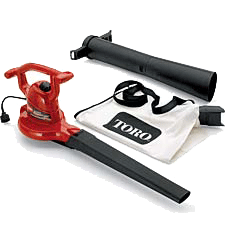 Seem crazy? Composting your yard waste and food scraps produces some of the best fertilizer you can get, and keeps everything "local." It's also a great place to use those Fall leaves, since good composting requires a mix of "brown" and "green" plant material. We're a fan of leaf vacuums, such as the Toro Ultra (in vacuum mode) which not only clean up fallen leaves quickly, but chop them into mulch and compost-ready material. Just keep a can of chopped leaves by your compost bin, and whatever you don't use for mulch, you can use throughout the year for composting.
Seem crazy? Composting your yard waste and food scraps produces some of the best fertilizer you can get, and keeps everything "local." It's also a great place to use those Fall leaves, since good composting requires a mix of "brown" and "green" plant material. We're a fan of leaf vacuums, such as the Toro Ultra (in vacuum mode) which not only clean up fallen leaves quickly, but chop them into mulch and compost-ready material. Just keep a can of chopped leaves by your compost bin, and whatever you don't use for mulch, you can use throughout the year for composting.
|
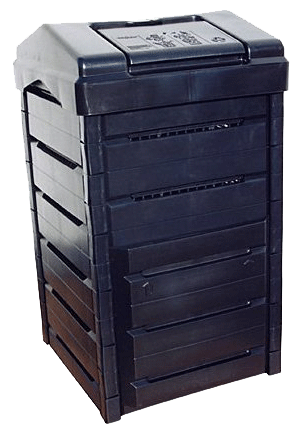 |
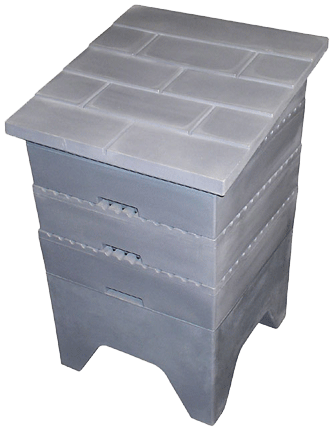
|
| The Garden Gourmet |
The Worm Chalet
|
- Grow some food
With the water and yard work issues relieved, spend a little of that free time and energy on a vegetable garden and/or some fruit trees, plants and vines. Adults and children alike love the connection to nature, and there's nothing tastier or more satisfying than food right from your backyard. We're big fans of the book How to Grow More Vegetables: Fruits, Nuts, Berries, Grains, and Other Crops Than You Ever Thought Possible on Less Land Than You Can Imagine by John Jeavons. It really works, believe us! If you're considering gardening in an urban area and/or near an older house, first test to see that the soil has not been contaminated with lead or other chemicals.
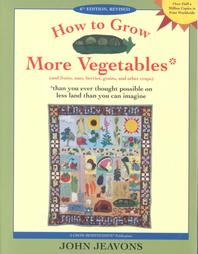
We'll conclude with a nice illustration from EBMUD's Bay-Friendly Gardening program which illustrates the benefits to a property with these principles applied.
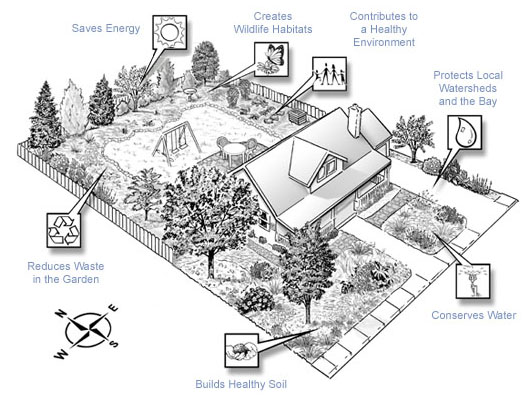
Useful Links
- Energy Efficiency: Wasted Water Equals Wasted Energy
In the last issue, the Energy Efficiency topic "Another Inconvenient Truth" began the discussion of energy consumption in ordinary activities. While we're on the topic of water conservation, we'll discuss another issue of water use - the energy required to provide it.
The California Energy Commission's “California’s Water – Energy Relationship Final Staff Report” states that water-related energy use consumes 19% of the state’s electricity, 30% of its natural gas, and 88 billion gallons of diesel fuel every year.
According to the CEC's "2005 Integrated Energy Policy Report," to supply California with water in 2005, it took an average of 3950 kWh/MG (Northern California) and 12700 kWh/MG (Southern California). (The difference is largely due to the energy required to pump water over the Tehachapi Mountains.) This equates to 3.95 watts-hours of electricity per gallon in Northern California and 12.7 watt-hours per gallon in Southern California.
According to the previous estimate of 4.752 million acre-feet (AF) of water consumed per year residentially (1,548,443,952,000 gallons), even at the Northern California's lower energy rate, that's 6,116,353,610 kWh of electricity, of which 4,388,483,715 kWh is used in outdoor watering. According to the California Energy Commission's "U.S. Per Capita Electricity Use By State In 2005," Californians used 7,032 kWh per capita in 2005, so this water-related electrical use is equivalent to the annual per capita electrical use of 869,789 Californians, about 1.2 times the population of San Francisco. Residential outdoor water-related energy use equaled the per capita consumption of 624,073 Californians, about half the population of San Diego. Note that we've used the lower value of water-related energy (Northern California), so the values are likely considerably higher in actuality.
On a more personal level, note that each gallon of water used in Northern California required about 4 Watt-hours of electricity to supply, along with natural gas and diesel fuel. Ignoring the natural gas and diesel fuel directly used in water supply (30% of the state's natural gas consumption, and 88 billion gallons of diesel fuel every year), this means that:
- 5 gallons of water represents the electricity supplied by one 'D' cell battery (0.018 kWh.)
- You can flush a low flow toilet (1.6 gallons per flush) about three times for a 'D' cell's worth of electricity. An older, less-efficient toilet might consume the energy of one to two 'D' cells per flush.
- A low-flow shower head flows at 2.5 gallons of water per minute so, in an efficient shower, you're using a 'D' cell's worth of water every two minutes. That's for a cold shower. If you're heating the water, more energy is involved, but we'll cover that next time.
- A kitchen faucet with an aerator flows at 2 gallons of water per minute, so a 'D' cell lasts 2.5 minutes.
- A 5/8" diameter garden hose delivers 17 gallons per minute, so you're using a 'D' Cell every 17.64 seconds, or 3.4 per minute. No wonder we're admonished to sweep the driveway, rather than hose it down! Furthermore, all that water carries oil and other pollutants into streams, creeks and waterbodies. In fact, if you wash your car in the driveway, realize that all that gunk ends up in the environment, as opposed to using a car wash, where the water is filtered, recycled and sent into the sewer system. Yes, the self-serve car wash costs $5, but it's a lot faster and easier too! In fact, the August 2, 1999 San Francisco Chronicle article "Our Poisoned Bay:
Despite end to direct piping of sewage, pollution worse now than 30 years ago" reports that roughly 3 millions gallons of oil be year end up in the bay-Delta watersheds.
- The average American uses about 100 gallons of water per day. In Northern California, that means 0.4 kWh of electricity per person, per day, to meet our water usage. This amount of electricity will:
- Keep a 100 Watt incandescent bulb lit for 4 hours, or the equivalent compact fluorescent lit for 16 to 20 hours.
- Keep a desktop computer idling for 5 hours or a laptop idling for 20 hours.
- Run a 10 SEER one ton air conditioner for about 20 minutes, a 17 SEER model for 34 minutes.
- Run a 1990 era refrigerator for about 4 hours, a new model for 8 hours.
- What about pedal power? This guy claims that charging a 95 amp-hour battery takes 8 to 10 hours, so he'd have to pedal for about 3 hours to generate this electricity, or 2 minutes per gallon (Northern California) or 6 minutes per gallon (Southern California.) This guy claims he can generate 140 Watts while pedaling, so he'd have to pedal for 2.8 hours to generate this electricty.
- Walk it off? A person who weighs 150 pounds and walks at 3 miles per hour uses about 4.5 calories per minute. There are 859,845 calories in a kWh, so 0.4 kWh would require walking for 76,430 minutes (1274 hours, or 53 days, or 4.4 months) or 3822 miles, about the distance from San Francisco to Houston and back. If you bump the speed up to 4.5 mph, the walker uses 7.05 calories per minute, and "only" has to walk for 48,786 minutes (1.1 months) and would travel 3659 miles. Running at 7.5 mph, the person would use 15.33 calories per minute, requiring a run of 22,436 minutes (15 days, 14 hours) and 2804 miles.
(That's a heck of an exercise plan! -ed.)
- The average household in the United States uses about 8,900 kilowatt-hours of electricity each year. This water-related daily electricity usage is equal to about one-sixth (or 4 hours) of an average household's electrical use.
You may also recall from last issue's "Energy Efficiency: Another Inconvenient Truth" that there's an average 80% energy loss in the generation and transmission of power, so these electrical consumption figures present about one-fifth of the actual energy consumed to provide the electricity. Generating one kilowatt-hour (kWh) of electricity requires the consumption of about 17,000 BTUs of natural gas or other fuel.
0.4 kWh of electricity represents about 6800 BTUs (.068 therms) of natural gas used daily for generation and transmission. What can this amount of energy do elsewhere?
- Boiling a gallon of water from the cold tap (~50° F) takes about 1349 BTUs. A gallon is equal to 16 cups, so you can make a cup of tea or coffee with about 84 BTUs. With 6800 BTUs, you can boil 5 gallons of water or make 80 cups of tea or coffee.
- A gas clothes dryer uses about 35,000 BTUs/hr when it's running, so you can run a dryer for 12 minutes.
- A gas BBQ uses 50,000 BTUs/hr, so you can run the grill for 8 minutes.
- A typical range uses 70,000 BTUs/hr, so you can run the stove for about 6 minutes.
- A solar water collector produces about 1000 BTUs per square foot per day, or about 32,000 BTUs per day for a typical 4'x8' collector, about 5 times this much energy.
- One BTU equals 252 calories, so this person would have to walk for 380,800 minutes (about 9 months) or about 19,040 miles (about three quarters of the way around the world) to consume this much energy.
What to do?
First, and foremost, recognize that water is a valuable and energy-intensive resource, and take steps to cut waste and conserve it. We've discussed outdoor water savings above, we'll talk about indoor savings next time. After waste reduction and conservation, greywater systems can get double duty out of the water you have delivered, and rainwater capture can bring it to you energy free. We'll look at these "alternative water systems" in the future.
- Indoor Air Quality: Healthy Indoor Air: Green Building Materials Aren't Enough
As we discussed last time in "Indoor Air Quality: A Breath of Fresh Air," there is a requirement in commercial buildings for fresh air exchange, but not one for homes. Even if your house is built or remodeled with the very greenest, lowest VOC finishes and fittings, there's still some sources of indoor air pollution you can't remove, at least without vacating your house! (Hint: it's your family.)
While it is yet to be adopted by the Building Code, the American Society of Heating, Refrigerating and Air-Conditioning Engineers (ASHRAE)
Residential Standard is likely to be. It requires 3 cubic feet per minute (cfm) per every 100 square feet of living area, plus 7.5 cfm per person. (I saw no mention of pets! -ed.) In the meantime, it's a good rule of thumb to provide for at least this much air exchange when you build or remodel.
How to?
First, you'll want to measure the air leakage ("infiltration") of your home, and take steps to correct and/or control it. The easiest way to do this is with a home performance test.
After that, there are several options for air exchange, presented here in general order of increasing cost and effectiveness.
- "Exhaust Only" Ventilation
An integrated approach for multiple fans is the Broan SmartSense® Ventilation System. This system automatically coordinates the operation of ventilation fans, running them intermittently throughout the day when necessary. The master Broan SmartSense® control monitors total run-time (manual and automatic) to deliver optimal ventilation from as many as ten fans.
Passive Inlet Vents
If there is insufficient infiltration to supply the makeup air, depressurization will result, and exhaust gases and other dirt air can be drawn into the house. In these cases, a passive inlet vent can be installed, to provide the require infiltration. (These seem to be a warm climate option, we'll look at others next.)
Tamarack's website has a good "Knowledge Base," covering such topics as Ventilation and Indoor Air Quality.
While it's best to use a quiet fan for ventilation (especially since it's on more often than in a standard bathroom application) no fan is SILENT. Toward that end, fans such as those made by Fantech are mounted inline with ducting, so that the fan can be located well away from the living space. In fact, these fans can be used to ventilate more than one bathroom, saving money and materials and drawing exhaust air from multiple locations, which should increase fresh air distribution.
Note that "Exhaust Only" Ventilation relies on depressurization to ventilate the house. Care must be taken to ensure that exhaust gases and dirty air are not drawn into the house (test, identify and plug those leaks, use only direct vent gas appliances in the house, ensure that there is adequate controlled infiltration to balance the exhaust).
In areas of high outdoor humidity, depressurization may cause excessive moisture to be drawn into the building's framing and insulation, giving rise to moisture and mold problems, so these systems are not recommended.
Exhaust Air Heat Pumps
A more elaborate but very energy efficient exhaust-only option is an exhaust air heat pump. Commonly used in Sweden, it transfers heat from the outgoing air into the domestic water tank. By employing a heat pump unit about the size of a window air conditioner, an exhaust air heat pump (EAHP) offers exceptional heat recovery efficiency. It can also provide most of the hot water needed by an average family. While the exhaust fan is controlled by timers, heat recovery engages only when hot water is needed. That means ventilation sometimes occurs without heat recovery. The operating characteristics of an EAHP can lead to greater air flow than required for a typical small house.
- "Supply Only" Ventilation
- "Balanced" Ventilation
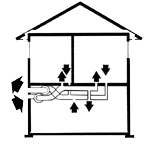 A more elaborate system, which avoids the pressure imbalance issues of the two previous approaches, and can also greatly reduce the energy loss from incoming air, is a "balanced" system with a dedicated ventilator. In homes without forced air, or in areas with high heating and/or cooling loads, it often makes sense to install a dedicated ventilator. There are several basic types:
A more elaborate system, which avoids the pressure imbalance issues of the two previous approaches, and can also greatly reduce the energy loss from incoming air, is a "balanced" system with a dedicated ventilator. In homes without forced air, or in areas with high heating and/or cooling loads, it often makes sense to install a dedicated ventilator. There are several basic types:
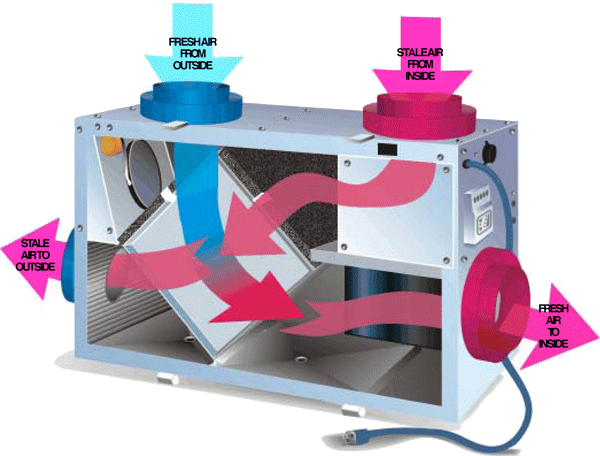
Air to Air Heat Exchanger
|
- Air Exchange Ventilators (AEVs)
An Air Exchange Ventilator balances the outgoing exhaust air with an equal amount of incoming air, so the inside pressure remains "balanced." Air Exchange Ventilators do not transfer heat between the air streams; they are are a less expensive and less efficient option than the two which follow.
- Heat Recovery Ventilators (HRVs)
A Heat Recovery Ventilator, aka "Air to Air Heat Exchanger," circulates air between the interior and exterior of a building and transfers the heat between the two airstreams without mixing the air together. In heating conditions, the warm exhaust air heats the cold incoming fresh air. In cooling conditions, the cool exhaust air cools the warm incoming air. Approximately 60 to 75% of the energy in the outgoing air is recovered. HRV's are usually recommended for colder climates with longer heating seasons.
- Energy Recovery Ventilators (ERVs)
An Energy Recovery Ventilator is similar to a Heat Recovery Ventilator except that it also exchanges moisture between the two airstreams. In heavy cooling conditions, this helps save energy, as much of the work of air conditioning is actually dehumidifiying (we'll discuss this more in future editions.) In very cold climates, where the incoming air is very dry, moisture from the warm interior exhaust air is transferred along with heat to the incoming air, increasing comfort. While this humidity transfer falls far short of a dehumidifier (the dessicant wheels used in many ERVs become saturated fairly quickly and the moisture transfer mechanism becomes less effective with successive hot, humid periods), it does help with energy savings and comfort. When installing ERVs in areas where the outdoor temperature falls below 23°F (-5°C) for more than 2 consecutive days, it is recommended that a defrost option be installed on the equipment.
|
 |
 |
 |
| Fantech Air Exchange Ventilator |
American ALDES Energy Recovery Ventilator |
Greenheck Energy Recovery Ventilator |
 |
 |
 |
| Fantech Heat Recovery Ventilator |
Aprilaire Energy Recovery Ventilator |
Honeywell Energy Recovery Ventilator |
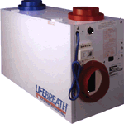 |
 |
 |
| Lifebreath Heat Recovery Ventilator |
Fantech Energy Recovery Ventilator |
RenewAire Energy Recovery Ventilator |
The NightBreeze®
The Davis Energy Group's NightBreeze® is a sophisticated balanced ventilator/HVAC controller designed for low humidity climates with hot days and cool nights (i.e. much of California.) The system senses the temperature outside and responds accordingly, exchanging cool air for hot when in cooling mode (it can also trigger air conditioning to cool outdoor air if necessary.) This can eliminate and/or greatly reduce the need for air conditioning. NightBreeze® exchanges and heats fresh outdoor air when in heating mode. The system is available in two models, one which integrates with an existing heating and cooling system and one which replaces the furnace with a hydronic heater, permitting the domestic hot water and space heating to be accomplished with one heating system. This can be a VERY efficient way to provide heating and domestic hot water, especially when coupled with solar water heating. We will discuss this is depth in the future.
See also:
Energy Consumption for Ventilation
In terms of the energy required for ventilation, an article entitled "The Cost of Exhaust-Only Ventilation" goes into some detail. Building a tight home to today's standards can cut the overall heat loss by 25 to 50%. An air to air heat exchanger typically recovers 60 to 75% of the energy in the exhaust air, and returns it to the home.
- Liveable Communities: Size Matters
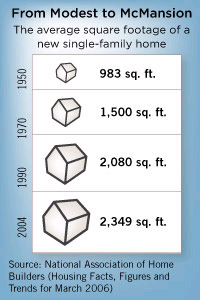 In most areas of concern to Green Building, there is an inescapable fact: "less is more." Basically, the larger the house, the more resources required to build it and the more energy required to inhabit and "operate" it.
In most areas of concern to Green Building, there is an inescapable fact: "less is more." Basically, the larger the house, the more resources required to build it and the more energy required to inhabit and "operate" it.
In last issue's "Liveable Communities: New Urbanism and Infill," we discussed a record high loss of farmland and wilderness. Large homes are a large part of this problem as well: larger and larger houses need larger and larger lots. In the last 30 years, the average floor area per person rose from 427 to 756 square feet and has tripled since the 1950s. Oversized homes and clumsy additions also compromise and destroy existing neighborhoods by ruining their scale and architectural integrity, shading, dwarfing and eliminating privacy of existing smaller homes and starting a size "arms race" to maintain privacy and comfort.
What to do? We've talked about New Urbanism and a move away from ever-sprawling 1950s style suburbs to a pre-war village lifestyle, with recreation, shopping and schools within walking distance and/or accessible by public transportation. Residential second units can make an important contribution, and are an increasingly accessible and attractive option.
On an individual basis, you can help by maintaining and improving existing housing stock. For many homes, that means additions. Done properly, a remodeling project, even if it results in a larger home, can increase the energy efficiency and health of the home, and an improved home in a developed area means potentially one less in the wilderness or farmland. Properly designed additions and remodels are assets to their neighborhoods.
In addition to green building in your remodel and/or addition, look to "smart" use of space. In November 2006, we talked about the The "Not-So-Big House" Philosophy, and its emphasis on quality and personalization over bulk. These are principals we swear by.
We're great at squeezing every inch of usable space out of a project, which saves our clients money and increases their satisfaction with the results. When we design additions, we also look at the existing space to see if we can reconfigure it for greater efficiency and continuity. We've made houses "bigger" without expanding them, floorplans flow better, rooms feel larger and kitchens work better, just through careful and creative design. Our goal for remodels and additions is to leave the house more beautiful than before, and render the additions "invisible" - completely integrated in the "new" home's architecture.
If you think we could be of assistance to you, please feel free to contact us at 415-258-4501 or email info@remodelguidance.com.
See also:
We are sorry if we appear the bearer of bad news, but we want to be "the bearer of important news." The good news is that many of these problems have accessible, affordable and pleasant solutions. Please stay tuned...
4. About Remodel Guidance
 |
Remodel Guidance is a residential design and consulting firm based in Marin County, California. We specialize in "Remodeling and Construction Strategy" - helping clients develop the most attractive, cost-effective, efficient and healthiest projects possible. We're restoration and rehabilitation enthusiasts with expertise in modernizing older homes while preserving and enhancing their character. We are dedicated environmentalists - experienced with, trained in, and committed to Green Building practices and design. Our services run the gamut from project consulting and permit expediting to complete plan packages and construction supervision. |
5. Meet the Designer
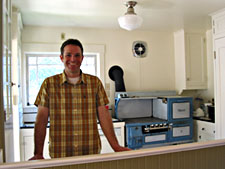 |
Graham Irwin has been working in the construction industry as a carpenter, general contractor and building designer since 1991. He relocated to the Bay area in 2001 and has built a successful design and consulting practice while restoring his own home, a 1922 California Bungalow. Dedicated to making the construction process accessible to the public, Graham teaches popular Community Extension classes on building permits, remodeling, construction and green building. He is an NCBDC Certified Professional Building Designer, a Professional Member of the American Institute of Building Design® and a licensed general contractor. A committed environmentalist, Graham is a member of Architects, Designers and Planners for Social Responsibility, The US Green Building Council and Build It Green, and is a Certified Green Building Professional. |
6. News & Upcoming Events
Marin County 2nd Unit Amnesty Ends in December, Remodel Guidance at San Rafael 2nd Unit Workshop, MMWD 2nd Unit Price Cuts
This is the "Summer of the Second Unit", for us and our clients, but it's also a big year for owners of illegal second units in unincorporated Marin County and San Rafael, and for anyone in Marin considering adding or legalizing a second unit, but dismayed by water fees.
We described Marin County's second unit amnesty program in RGCC November 2006 (see Marin County 2nd Unit Amnesty: Turn your "Out-Law" Unit into an "In-Law" Unit.) This program will continue until the end of the year, at which point fees will double and fines will be reinstituted. More information about this program is here. Note that fees for newly constructed second units are discounted during this period as well.
The City of San Rafael continually offers Second Unit Workshops. While these workshops are oriented toward projects within San Rafael, much of the information is valuable to others. Remodel Guidance has been invited to participate and lead designer Graham Irwin will be appearing at the next workshop, Wednesday, September 26, from 7 to 8:30 PM at the San Rafael Community Center, 618 "B" Street, San Rafael. Admission is free. For more information, contact Linda Jackson at the City of San Rafael Planning Department, 415-485-3067.
The Marin Municipal Water District recently expanded its 50-percent fee reduction for water connection to houses with second living units to all of Marin County. Here's a press release.
Remodel Guidance joins NorCal Solar
Remodel Guidance recently became a member of The Northern California Solar Energy Association. They're a non-profit promoter of Solar Energy who've been around since 1975. We're very enthusiastic about solar energy and proud to support and be a part of this organization. They're a great resource.
Upcoming Classes
In addition to private consulting, we offer public workshops. Here are the most immediate; stay tuned for additional offerings throughout the Bay Area and beyond.
-
An Insider's Introduction to Green Building
Learn about one of the most exciting and rapidly growing fields in construction today. This lecture/discussion covers the theory, methods, materials and construction techiques of environmentally aware remodeling and construction and dispels some commonly held rumors and myths. The instructor is a professional designer, general contractor and Certified Green Building Professional.
Time and Date: Wednesday, August 22, 6:00-9:00 PM
Place: 305 Main Street, Redwood City, CA (directions)
Fee: $15
An Insider's Introduction to Green Building
Time and Date: Wednesday, September 19, 6:00-9:00 PM
Place: 305 Main Street, Redwood City, CA (directions)
Fee: $15
Registration:
Contact Danny Beesley at Green Building Exchange, (650) 369-4900.
-
Navigating the Remodeling Maze
Learn the ropes of obtaining building permits before you complete your plans. This thorough exploration of the permit process and Q&A session will help you avoid unnecessary red tape and expenses by designing your project around established requirements. Whether you are contemplating a remodeling project, in the middle of one, or thinking of buying a fixer-upper, this class will save you money, time and heartache.
Time and Date: Wednesday, September 12, 6:30-9:30 PM
Place: Marina Middle School, Room TBD, 3500 Fillmore St @ Chestnut, San Francisco
Fee: $55, $45 (If registered ONE WEEK before the class begins)
Period Perfect Remodeling
Whether you're a restoration fanatic or interested in a few period architecture touches and whether you're restoring, remodeling, expanding or building new, if you love vintage architecture this class is for you. Learn how to preserve, enhance and/or restore the historical integrity of your home while addressing modern building requirements, conveniences and technology. Learn how to get an authentic look with new materials and how to find and use architectural salvage for a great look, huge savings, and the ultimate in green building. You'll learn plenty of tips, techniques, sources, tricks of the trade and do's and don'ts from a professional designer and contractor. Every house has a soul. Whether yours is fairly original or it's had a "checkered past," this class will help you get it back in touch with its roots.
Time and Date: Wednesday, October 3, 6:30-9:30 PM
Place: Marina Middle School, Room TBD, 3500 Fillmore St @ Chestnut, San Francisco
Fee: $55, $45 (If registered ONE WEEK before the class begins)
Introduction to Green Building
Learn about one of the most exciting and rapidly growing fields in construction today. This class discusses the theory, methods, materials and construction techiques of environmentally aware remodeling and construction. The instructor is a professional designer, general contractor and Certified Green Building Professional.
Time and Date: Wednesday, November 7, 6:30-9:30 PM
Place: Marina Middle School, Room TBD, 3500 Fillmore St @ Chestnut, San Francisco
Fee: $55, $45 (If registered ONE WEEK before the class begins)
Registration
- Online: click here
- Mail this form, fax it to 415-561-1849, or deliver it to:
Fort Mason Art Campus
Laguna & Marina Blvd - Bldg B
San Francisco, CA 94123
Phone: 415-561-1860
Fax: 415-561-1849
For futher information, contact The City College of San Francisco Continuing Education Program at 415 561-1860 or visit their website.
-
Navigating the Remodeling Maze
Learn the ropes of obtaining building permits before you complete your plans. This thorough exploration of the permit process and Q&A session will help you avoid unnecessary red tape and expenses by designing your project around established requirements. Whether you are contemplating a remodeling project, in the middle of one, or thinking of buying a fixer-upper, this class will save you money, time and heartache.
Time and Date: Tuesday, September 25, 6-9 PM
Place: Drake High School, 1327 Sir Francis Drake Blvd., San Anselmo
Fee: $35 + $5 materials fee due at class
Introduction to Green Building
Learn about one of the most exciting and rapidly growing fields in
construction today. This class discusses the theory, methods, materials
and construction techiques of environmentally aware remodeling and
construction. The instructor is a professional designer, general
contractor and Certified Green Building Professional.
Time and Date: Tuesday, October 9, 6-9 PM
Place: Drake High School, 1327 Sir Francis Drake Blvd., San Anselmo
Fee: $35 + $5 materials fee due at class
Registration
- Online: click the title(s) of the course(s) you are interested in above, or visit the website..
- Telephone: Contact the Tamalpais Union High School District's Adult and Community Education Program at 415-945-3730 between 8 AM and noon, Monday through Thursday.
- Email: comed-mail@tamdistrict.org
- Fax: Fax a registration form to 415-945-3767.
- Mail: Mail a registration form to P.O. Box 605, Larkspur, CA 94977.
- In person registrations are accepted at 375 Doherty Drive, Larkspur, 8 AM to noon, Monday through Friday.
- Walk-in registrations are also accepted at the start of the class.
-
Period Perfect Remodeling
Whether you're a restoration fanatic or interested in a few period architecture touches and whether you're restoring, remodeling, expanding or building new, if you love vintage architecture this class is for you. Learn how to preserve, enhance and/or restore the historical integrity of your home while addressing modern building requirements, conveniences and technology. Learn how to get an authentic look with new materials and how to find and use architectural salvage for a great look, huge savings, and the ultimate in green building. You'll learn plenty of tips, techniques, sources, tricks of the trade and do's and don'ts from a professional designer and contractor. Every house has a soul. Whether yours is fairly original or it's had a "checkered past," this class will help you get it back in touch with its roots.
Time and Date: Thursday, September 20, 6-9 PM
Place: 1692 Emeritus Hall, Santa Rosa Campus
Fee: $49.00 (includes $5.00 of materials)
Adding A Second Unit
Whether you own a house and wish to add a second unit, want to buy a house and add a unit or have a second unit you'd like to legalize, there have been big changes in state and local law that make it much easier to obtain the necessary permits. This three-hour workshop will guide you through the requirements of your community and answer questions specific to your project.
Time and Date: Thursday, September 27, 6-9 PM
Place: 1692 Emeritus Hall, Santa Rosa Campus
Fee: $49.00 (includes $5.00 of materials)
Introduction to Green Building
Learn about one of the most exciting and rapidly growing fields in
construction today. This class discusses the theory, methods, materials
and construction techiques of environmentally aware remodeling and
construction. The instructor is a professional designer, general
contractor and Certified Green Building Professional.
Time and Date: Thursday, November 1, 6-9 PM
Place: 1692 Emeritus Hall, Santa Rosa Campus
Fee: $49.00 (includes $5.00 of materials)
Registration
- Online: click the title(s) of the course(s) you are interested in above.
- Telephone: Call 707-527-4824, 24 hours a day, 7 days a week. Please have your Visa or MasterCard (no American Express or Discover) in hand and your completed registration form ready. (The system is voice-activated.)
- Mail: Mail a completed registration form or photocopy with a check (made payable to SRJC) or your Visa/MasterCard number, to Community Education Registration, 1501 Mendocino Avenue, Santa Rosa, CA 95401.
- Fax: Fax a completed registration form with Visa/MasterCard information to 707-527-4870.
- In Person: Register at the Community Education office, 1990 Armory Drive, corner of Armory Drive and Elliott Avenue, Santa Rosa campus, during business hours. Easy parking!
For futher information, you may contact the Santa Rosa Jr. College Community Education Department at 707-527-4371 or 707-527-4372, Monday through Friday, 8:00 AM - 5:00 PM or visit their website.
7. In the Works
Keep an eye out in upcoming issues for:
- "My Atomic Green Home" - a Fairfax home gets a Mid-Century Modern Remodel with major green features.
- "My Vintage Solar Cottage" - A Thermosiphon Solar Water Heater installed on a 1920s style second unit
8. Contact Us
For general questions or to learn more about our services, please feel free to contact us:
Telephone: 415-258-4501
Email: info@remodelguidance.com
Web: www.remodelguidance.com
|



















